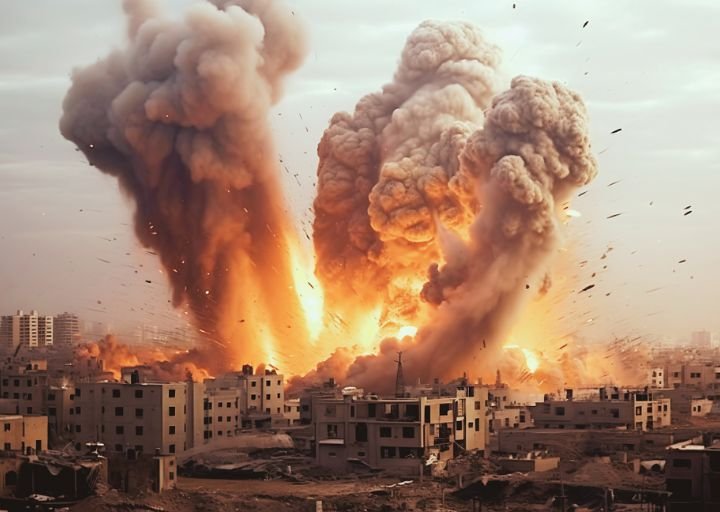North Korea South Korea Balloons, Rising Tensions and Security Concerns
The skies over the Korean Peninsula have once again become a theater of tension as propaganda balloons from North Korea drift into South Korean territory. This age-old tactic, steeped in historical animosity and psychological warfare, has sparked fresh concerns and reactions from both sides of the border. Understanding these developments is crucial as they have significant implications for regional stability and international relations.
Thank you for reading this post, don't forget to subscribe!The relationship between North and South Korea has always been fraught with tension, rooted in a complex history of conflict, ideological divides, and sporadic attempts at diplomacy. Propaganda balloons have long been a tool in this strained relationship, dating back to the Korean War. These balloons, often carrying leaflets, USB sticks, and even food, are meant to spread political messages and undermine the opposing government’s authority.
In the latest incident, several balloons launched from North Korea were found in South Korean territory, causing immediate alarm. These balloons, carrying anti-South Korean propaganda, were detected earlier this month, triggering a swift response from South Korean authorities. The timing of this incident is particularly critical, coinciding with heightened military drills and political statements from both nations.


North Korea’s government has justified these actions as a necessary response to perceived threats from the South, while South Korea has condemned the act as a provocative and dangerous escalation. The South Korean military has increased its vigilance along the border, deploying additional surveillance and interception technologies to mitigate potential threats.
The incident has further strained the already tenuous relationship between North and South Korea. South Korean President, Yoon Suk-yeol, has called for international condemnation of North Korea’s actions, emphasizing the need for collective security measures. In contrast, North Korean leader, Kim Jong-un, has framed the balloon launches as a defensive measure against South Korean and U.S. aggression.
Internationally, reactions have been mixed. The United States has reiterated its support for South Korea, while urging restraint from both sides. China and Russia have called for dialogue and de-escalation, highlighting the need for regional stability.
The presence of propaganda balloons raises significant security concerns for South Korea. These balloons could potentially carry hazardous materials, posing a direct threat to civilians and military personnel. In response, the South Korean military has enhanced its defensive posture, including increased patrols and the deployment of advanced detection systems.
Conversely, North Korea has bolstered its own defenses, citing the need to protect its sovereignty. This military buildup includes not only traditional defenses but also electronic warfare capabilities aimed at disrupting South Korean countermeasures.
South Korean citizens have expressed a mixture of fear and resilience. Many living near the border areas are accustomed to such provocations but remain wary of the potential for escalation. In contrast, information from North Korean citizens is scarce due to the regime’s tight control over media and communication.
The media in both countries has played a pivotal role in shaping public perception. South Korean news outlets have extensively covered the incident, emphasizing the threat and the government’s response. North Korean state media, meanwhile, portrays the balloon launches as a heroic act of resistance against foreign oppression.
South Korean citizens have expressed a mixture of fear and resilience. Many living near the border areas are accustomed to such provocations but remain wary of the potential for escalation. In contrast, information from North Korean citizens is scarce due to the regime’s tight control over media and communication.
The media in both countries has played a pivotal role in shaping public perception. South Korean news outlets have extensively covered the incident, emphasizing the threat and the government’s response. North Korean state media, meanwhile, portrays the balloon launches as a heroic act of resistance against foreign oppression.
Political analysts and security experts have weighed in on the situation, offering various perspectives. Some argue that these incidents are a strategic move by North Korea to test South Korea’s responses and international resolve. Others believe it reflects internal pressures within North Korea, using external provocations to unify its populace.
Experts also predict that such incidents may continue as part of North Korea’s broader strategy of psychological warfare. The effectiveness of these tactics, however, remains debatable, with some suggesting that they only serve to harden South Korea’s resolve.
Comparing the current incident to previous ones reveals an evolution in tactics. Earlier balloon campaigns were relatively rudimentary, focusing mainly on leaflet distribution. Today’s balloons are more sophisticated, potentially carrying electronic media and other forms of modern propaganda. This shift reflects broader changes in North Korea’s approach to psychological operations.
The legality of these balloon launches is complex. South Korea has stringent laws against the dissemination of propaganda from the North, viewing it as an act of aggression. International law, too, frowns upon such actions, considering them a violation of national sovereignty and a potential threat to peace.
Beyond the political and security dimensions, there are significant humanitarian concerns. Civilians living in border areas are often the most affected, facing the dual threat of direct harm and psychological stress. The repeated exposure to these incidents can have lasting impacts on their mental health and sense of security.
The technology behind modern propaganda balloons has advanced significantly. Today’s balloons can carry more diverse payloads, including digital media and potentially harmful substances. This technological evolution makes them a more versatile tool in psychological warfare, albeit one that is increasingly detectable and counterable by advanced military technologies.
The role of media in these incidents is critical. Propaganda, by its nature, aims to influence perception and morale. The media’s portrayal of these events can either amplify or mitigate their impact. In South Korea, the media tends to highlight the threat and the government’s defensive measures, while North Korean media glorifies the actions as part of their resistance narrative.
Looking ahead, the potential for future incidents remains high. As long as the underlying political and ideological divides persist, North Korea is likely to continue using propaganda balloons as a tool of psychological warfare. The long-term impact on North-South relations will depend on the responses from both governments and the international community.
The recent balloon incident is a stark reminder of the enduring tensions on the Korean Peninsula. While technological advancements have changed the nature of these provocations, the underlying issues remain deeply rooted in history and politics. Understanding these dynamics is essential for fostering peace and stability in the region.
Have questions or need more information? Feel free to reach out to us through our Contact Page. You can also learn more about our mission and team on our About Page.
Stay connected with RIGHWAY on social media. Follow us on Facebook, Twitter/X, and Instagram for the latest news updates, behind-the-scenes content, and more. Engage with us online and be a part of our growing community.
Sign up for our newsletter to get the latest news delivered straight to your inbox. Follow us on social media for real-time updates and engaging content.
Stay connected with RighWay, where your news journey begins.
More like this Top News
- EV Charging vs. Gas Prices: The Surprising Savings in 2024
- Surviving the COVID Summer Wave: Top Tips to Stay Safe
- Top 10 Peloton Instructors Who Will Transform Your Workout Routine
- What is the Bird Flu Pandemic?
- How to Treat Bee Sting Pain: Effective Remedies and Tips
- Lung Cancer: Can It Truly Be Cured?
- Types and Categories of Heart Health Supplements
- How Maye Musk’s flexitarian diet keeps her fit at 76
- Where is Uefa Euro 2024?
- Can Health Insurance Be Cancelled at Any Time?
- What Tony Awards Did Hamilton Win?
- What Will Tesla Stock Be Worth in 2025?
- Types of Pregnancy Tests
- Apple Intelligence: Transforming Tech | Latest Updates
- Warren Buffett: Inspire with His Unique Investment Strategies
- Jake Gyllenhaal’s Shocking New Role Will Surprise You!



